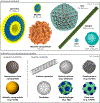Nanocarriers for the Delivery of Medical, Veterinary, and Agricultural Active Ingredients
- PMID: 32125825
- PMCID: PMC8085836
- DOI: 10.1021/acsnano.0c00173
Nanocarriers for the Delivery of Medical, Veterinary, and Agricultural Active Ingredients
Abstract
Nanocarrier-based delivery systems can be used to increase the safety and efficacy of active ingredients in medical, veterinary, or agricultural applications, particularly when such ingredients are unstable, sparingly soluble, or cause off-target effects. In this review, we highlight the diversity of nanocarrier materials and their key advantages compared to free active ingredients. We discuss current trends based on peer-reviewed research articles, patent applications, clinical trials, and the nanocarrier formulations already approved by regulatory bodies. Although most nanocarriers have been engineered to combat cancer, the number of formulations developed for other purposes is growing rapidly, especially those for the treatment of infectious diseases and parasites affecting humans, livestock, and companion animals. The regulation and prohibition of many pesticides have also fueled research to develop targeted pesticide delivery systems based on nanocarriers, which maximize efficacy while minimizing the environmental impact of agrochemicals.
Keywords: agrochemical delivery; cancer; clinical trials; drug delivery; gene delivery; nanocarrier; nanomedicine; pest management; precision farming; veterinary medicine.
Conflict of interest statement
The authors declare no competing financial interest.
Figures


References
-
- Eder J; Herrling PL Trends in Modern Drug Discovery. In New Approaches to Drug Discovery; Nielsch U, Fuhrmann U, Jaroch S, Eds.; Springer International Publishing: Cham, 2016; pp 3–22. - PubMed
-
- Hogan G; Tangney M The Who, What, and Why of Drug Discovery and Development. Trends Pharmacol. Sci 2018, 39, 848–852. - PubMed
-
- Holohan C; Van Schaeybroeck S; Longley DB; Johnston PG Cancer Drug Resistance: An Evolving Paradigm. Nat. Rev. Cancer 2013, 13, 714–726. - PubMed
-
- Maeda H; Tsukigawa K; Fang J A Retrospective 30 Years after Discovery of the Enhanced Permeability and Retention Effect of Solid Tumors: Next-Generation Chemotherapeutics and Photodynamic Therapy—Problems, Solutions, and Prospects. Micro-circulation 2016, 23, 173–182. - PubMed
Publication types
MeSH terms
Substances
Grants and funding
LinkOut - more resources
Full Text Sources
Other Literature Sources
Medical

